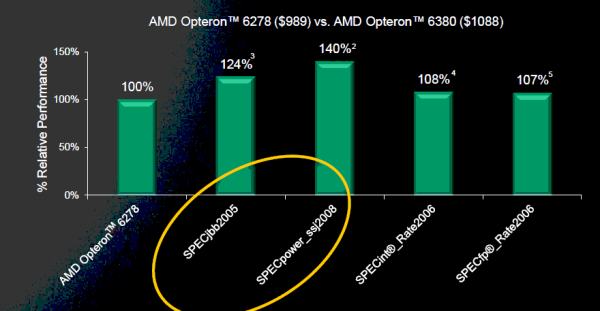AMD Launches Opteron 6300 series with "Piledriver" cores
by Johan De Gelas on November 5, 2012 12:00 PM EST- Posted in
- IT Computing
- CPUs
- AMD
- Opteron
- Abu Dhabi
- Piledriver
Performance According to AMD
For the first time in Opteron history, AMD was not able to provide us with samples before the launch. We are working with them to make sure we can show our independent benchmarks. Until then we have to work with what we AMD has published.
The clock speed advantage of the 6380 at 2.5GHz is 4%, so the SPEC CPU tests show that Piledriver is about 4% more effficient per clock when we focus on high IPC, low MLP benchmarks. However, as we have shown in previous articles, server applications behave very differently from SPEC CPU benchmarks.
AMD claims 24% higher performance in the Java benchmark SPECJBB, but that is an inflatable benchmark. We do not want to dismiss the benchmark result immediately, but AMD does not disclose the JVM settings. The following settings were disclosed:
The Opteron 6380 based server:
77.9W at Active Idle, 308W and 1,636,298 ssj_ops at 100% of target load, and 4,040 overall ssj_ops/watt using 2 x AMD Opteron™ processors Model 6380 in Supermicro 1022G-NTF server, 64GB (8 x 8GB DDR3-1600) memory, Supermicro PWS-563-1H20 power supply, 240GB SATA disk drive, Microsoft® Windows Server® 2008 R2 x64 Enterprise Edition.
The Opteron 6278 based server:
82.6W at Active Idle, 320W and 1,233,423 ssj_ops at 100% of target load, and 2,892 overall ssj_ops/watt using 2 x AMD Opteron™ processors Model 6278 in Supermicro 1022G-NTF server, 64GB (8 x 8GB DDR3-1600) memory, Supermicro PWS-563-1H20 power supply, 240GB SATA disk drive, Microsoft® Windows Server® 2008 R2 x64 Enterprise Edition.
It is very likely that some new JVM performance boosting tricks contribute more to the performance increase than better processor performance. Most of those JVM tricks are unacceptable in a real-world Java application, so we fear that the SPECJBB results tell us very little. As just one example, AMD uses 16 JVMs on 32 integer cores to obtain the SPECJBB results. That means that each JVM is running on one module, minimizing the coherency traffic and optimizing the cache hits. Of course everybody that posts these SPECJBB scores uses these kinds of very unrealistic settings, but it also means that we can deduce very little about the real performance increase that the Piledriver cores offer.
The power numbers of the SPECPower_ssj2008 benchmarks make us somewhat optimistic though. The 40% increase in performance/watt is clearly not the result of JVM performance tricks alone. The idle and maximum power numbers also confirm that the Opteron 6300 is quite a bit more efficient in server loads than the 6200. We estimate that the new Opteron offers a 20% (or better) higher performance/watt ratio in the real world. Let us wrap up with a look at the SKUs and prices.











22 Comments
View All Comments
dig23 - Wednesday, December 12, 2012 - link
Can anybody tell me what is the Family and model number for Piledriver Abudhabi (opteron 6300) ?? and how to find for other models...and could not find BKDG for same ...any help is appreciated ?
Rabman - Thursday, December 20, 2012 - link
Like "Bulldozer" before it, "Piledriver" based cores are Family 15h but are in a different range of model numbers.The BKDG you're looking for is here:
http://support.amd.com/us/Processor_TechDocs/42300...